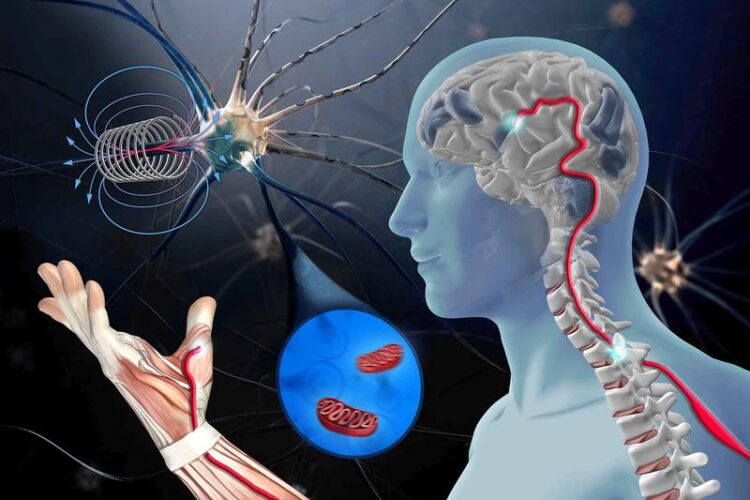A Potential New Therapeutic Approach for Curing Neurodegenerative Diseases

In the cell culture experiment: Disrupted motor neurons of ALS patients are stimulated with magnetic pulses (coil top left) and regain their original performance.
c) HZDR/Sahneweiß
Reactivating Damaged Motor Neurons Using Magnetic Fields.
Motor neurons in healthy individuals send signals to the skeletal muscles. ALS, however, is currently an incurable, neurodegenerative disease in which motor neurons are severely damaged and can therefore no longer transmit these signals. An interdisciplinary team at HZDR has proven in cell experiments that magnetic fields can restore impaired motor neurons. This could serve as the groundwork for an entirely new therapeutic approach in curing neurodegenerative diseases, as currently reported in Cells, the international journal for cell and molecular biology as well as biophysics (DOI: 10.3390/cells12111502).
Amyotrophic lateral sclerosis (ALS) is an incurable motor neuron disease, which generally leads to death within two to five years. No successful therapy has yet been developed.
Thomas Herrmannsdörfer, Helmholtz-Zentrum Dresden-Rosendorf (HZDR), department head at HZDR’s Dresden High Magnetic Field Laboratory (HLD), works closely with physician Prof. Richard Funk. Together with colleagues from the Universities of Dresden and Rostock, they have assembled a research team stemming from the fields of physics, medicine, biology and biotechnology to investigate the therapeutic effect of magnetic fields on impaired motor neurons. In addition to the HLD, the HZDR’s Center for Radiopharmaceutical Cancer Research (ZRT) was also involved in the project.
Promising in vitro trials
The cell biologists first reprogrammed skin cells from both healthy individuals as well as from ALS patients into motor neurons. Motor neurons possess projections (axons) measuring up to one meter long, which are used to transport substances and to transmit information. Researchers led by Dr. Arun Pal (HZDR) subsequently exposed motor neurons programmed in this way to magnetic fields of different strengths for different periods of time in petri dishes. Additional magnetic field parameters such as frequency, orientation and waveform were also varied. “In the numerous series of experiments, we were able to demonstrate that the motor neurons from ALS patients respond to the magnetic fields,” Pal says, summarizing the results. “The axonal transport of mitochondria (the power stations of the cell) and other organelles that are impaired in ALS cells is reactivated by stimulation with magnetic fields. Furthermore, the axonal regeneration—which is the ability to regrow and reconnect—can be restored.” The team used live cell imaging and cell biological methods for their study. At the same time, the team could also demonstrate that healthy cells were not damaged by this stimulation.
Although the results are a milestone for Herrmannsdörfer and his team, he nevertheless puts them into perspective: “We regard these in vitro results as an encouraging approach on the path to a potential novel therapy for ALS as well as other neurogenerative diseases. We also know, however, that detailed follow-up studies are required to corroborate our findings.”
Transition to in vivo studies
Scientists are subsequently planning long-term and in vivo studies to further expand the therapeutic potential of magnetic field treatments. These studies include investigating the optimal technical parameters of the applied magnetic field. In addition, they aim to deepen the understanding of the cellular response to the various magnetic stimuli and therefore better comprehend the underlying mechanisms. They will also study how cellular changes in other neurodegenerative disorders such as Parkinson’s, Huntington’s and Alzheimer’s diseases react to magnetic field stimulation. In the long-term, the scientists are planning clinical pilot studies using specialized equipment for magnetic simulation.
The research project is now called “ThaXonian” – Magnetic Axon Therapy. The pioneers of the project include:
1. idea, concept and project management: Richard Funk (TU Dresden) and Thomas Herrmannsdörfer (HZDR)
2. stem cell technology, skin cell reprogramming, establishment of neuronal cell lines: Andreas Hermann (University of Rostock)
3. cellular assay development including video evaluation: team of Andreas Hermann (Rostock University) and Arun Pal (HZDR)
4. magnetic field technology and coil construction: Thomas Herrmannsdörfer with HLD team at HZDR
5. cellular assays in the magnetic field: Arun Pal, Wonphorn Kandhavivorn, Thomas Herrmannsdörfer with HLD team at HZDR as well as Jens Pietzsch with ZRT team at HZDR.
Wissenschaftliche Ansprechpartner:
Dr. Arun Pal I HZDR Dresden High Magnetic Field Laboratory
Phone: +49 351 260 3549, 2631 I Email: a.pal@hzdr.de
Dr. Thomas Herrmannsdörfer I HZDR Dresden High Magnetic Field Laboratory
Phone: +49 351 260 3320 I Email: t.herrmannsdoerfer@hzdr.de
Originalpublikation:
W. Kandhavivorn, H. Glaß, T. Herrmannsdörfer, T. M. Böckers, M. Uhlarz, J. Gronemann, R. H. W. Funk, J. Pietzsch, A. Pal and A. Hermann: Restoring Axonal Organelle Motility and Regeneration in Cultured FUS-ALS Motoneurons through Magnetic Field Stimulation Suggests an Alternative Therapeutic Approach, Cells (2023) DOI: 10.3390/cells12111502
Weitere Informationen:
Media Contact
All latest news from the category: Interdisciplinary Research
News and developments from the field of interdisciplinary research.
Among other topics, you can find stimulating reports and articles related to microsystems, emotions research, futures research and stratospheric research.
Newest articles

Innovative 3D printed scaffolds offer new hope for bone healing
Researchers at the Institute for Bioengineering of Catalonia have developed novel 3D printed PLA-CaP scaffolds that promote blood vessel formation, ensuring better healing and regeneration of bone tissue. Bone is…

The surprising role of gut infection in Alzheimer’s disease
ASU- and Banner Alzheimer’s Institute-led study implicates link between a common virus and the disease, which travels from the gut to the brain and may be a target for antiviral…

Molecular gardening: New enzymes discovered for protein modification pruning
How deubiquitinases USP53 and USP54 cleave long polyubiquitin chains and how the former is linked to liver disease in children. Deubiquitinases (DUBs) are enzymes used by cells to trim protein…



